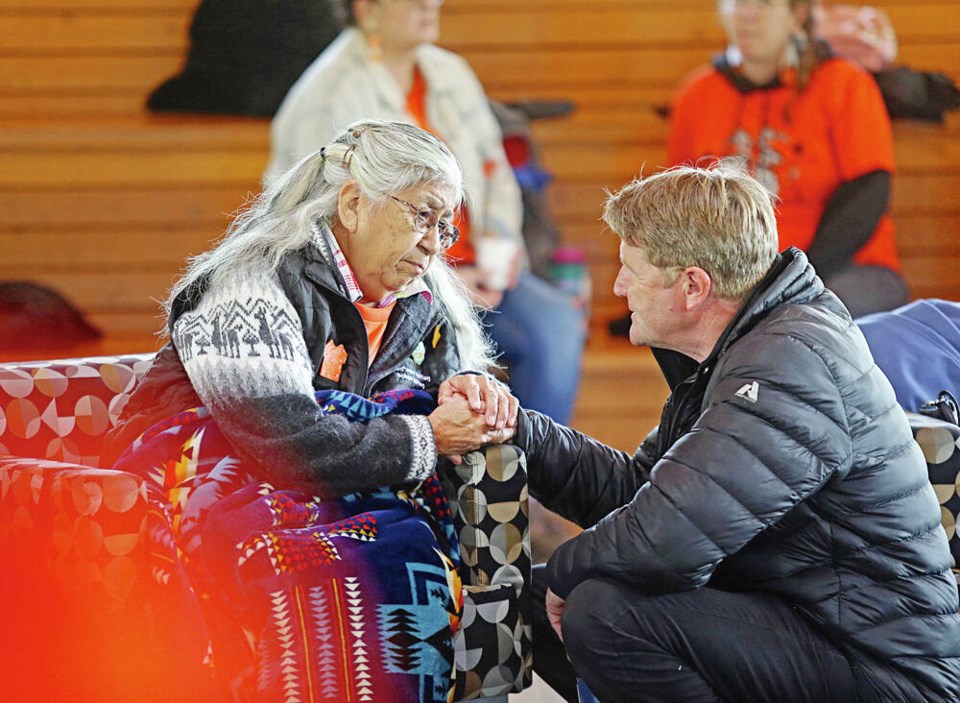Even if you can’t attend an event on Sept. 30, there are many meaningful ways to recognize the National Day for Truth and Reconciliation, says an Indigenous communications specialist.
Wearing orange, even if you’re not gathering with others, can have a very real impact on someone’s day, said Charla Huber, who is First Nations and Inuit.
“I’ve heard from residential school survivors that when they see someone wearing an orange shirt, they feel heard and supported.”
Eddy Charlie, a survivor of Kuper Island Indian Residential School and co-organizer of Victoria Orange Shirt Day, said people can take it one step further and post photos of themselves wearing an orange shirt to social media with the words: “I support residential school survivors and their journey towards healing.”
Charlie said his work on Orange Shirt Day over the past eight years has not been easy because people often push back, questioning the importance of continuing to talk about residential schools.
When he sees people wearing orange, it gives him hope, he said.
Here are a few other ideas:
Watch a film about residential schools
There are many films easily available on streaming platforms that show the reality of residential schools, said Huber.
She suggests watching Holy Angels, a short film that focuses on the story of a woman who was forced to attend a residential school in Alberta; We Were Children, a feature film that follows two young children in a residential school; and Reel Injun, which documents the history of how Indigenous people have been depicted on screen.
Read a book
Charlie recommends reading Phyllis Webstad’s The Orange Shirt Story, which tells the origin story of Orange Shirt Day on Sept. 30, now the National Day for Truth and Reconciliation. Webstad’s story of having her new orange shirt, a gift from her grandmother, taken from her at six years old on her first day of residential school near Williams Lake inspired Orange Shirt Day.
“It talks about what happened to children when they were taken away from their home, the loss they experienced and the sense of being vulnerable as children and not being able to walk away with any feelings of value when they left residential schools,” Charlie said.
Connect with a survivor to hear their story firsthand
Charlie said some elders are interested in sharing their stories of surviving residential school and suggests contacting the office of a First Nation in your area to ask for help connecting with an elder who is willing to have a one-on-one chat.
Read survivors’ stories
Kristin Spray, who co-organizes Victoria Orange Shirt Day with Charlie, said if people can’t hear survivors’ stories in person, they can read firsthand accounts compiled by the Truth and Reconciliation Commission.
“It’s important, I think, as non-Indigenous people to experience some of this pain, to hear these truths and let it sit in our hearts, allow it to feel uncomfortable, create emotion, and allow those emotions over time — beyond one day or one month — to help us make those connections of what our responsibilities are in living on these traditional Indigenous lands,” Spray said.
Read the 94 calls to action by the Truth and Reconciliation Commission
Spray recommends reading the calls to action and looking for the recommendations that apply to you to think about how you can incorporate the actions into your life.
Learn some words in a local Indigenous language
Learn how to say “hello,” “thank you” and other words or phrases in the language of the First Nation where you live.
“If you want to show your respect in a good way, you learn about the language from the place where you’re going to go speak or participate in a ceremony. You learn and understand their customs. That shows you respect the place where you’re going, the place you’re going to be standing, and it shows where you stand as a human being,” Charlie said.
Take a moment to reflect
Huber said people don’t need to have all the information about residential schools in order to respect the sombre nature of the day.
If people are trying to honour the day, they can take a moment on their own to imagine children torn from their families and parents told they have to give up their children or go to prison, and sit with the feelings that brings up, Huber said.




